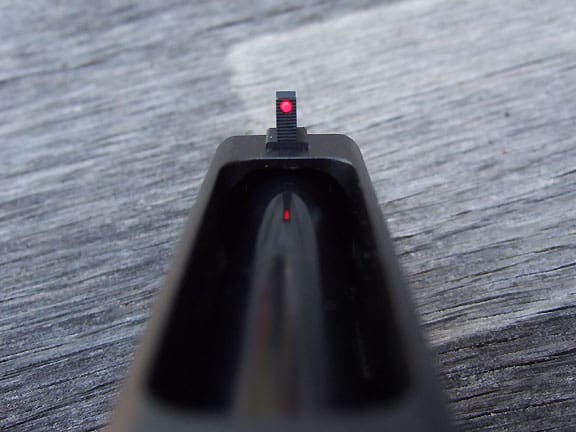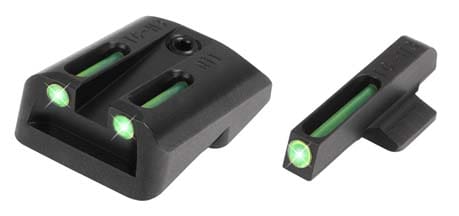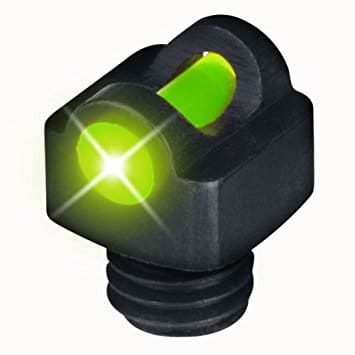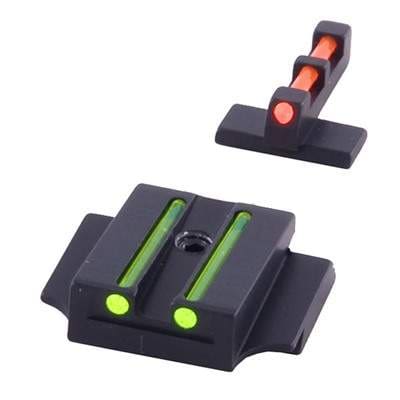Besides tritium night sights, fiber optics sights are the best types of everyday carry or home defense handgun sights. For those who practice the front sight press, a fiber optic sight set (or at least a fiber optic front sight) is a highly-advised upgrade. Likewise, it’s a good feature to look for in either a carry gun that will go in a concealed carry holster or a nightstand gun. But which one to get?
Some are fiber optic sights are green, some are red, others orange and some yellow. Rule of thumb: go for for green or yellow sights. Green and yellow fiber optic sights have advantages over red that go beyond preference. Because science!
Yellow and green light occupy more of the visible spectrum. Light comes in many colors, determined by its wavelength. White light, which is the color we usually perceive, is actually a combination of all the colors across the entire spectrum. That’s why when light is sent through a refractory object (such as a prism) it splits into the various colors of the spectrum and looks great on album covers.

Green light has a wavelength of anywhere between 510 nanometers (where the wavelength of blue light ends) and 570nm, the wavelength at which yellow light begins. Red light starts at 650 nm and goes up from there; wavelengths of red light that can’t be seen by the human eye due to a too-high wavelength are the infrareds.
The human eye picks up light with wavelengths between 400 nm and 700 nm. Red light, therefore, occurs closer to the limits of human vision — the reason some people find green lasers more visible in low light conditions. Yellow light occurs at close the same wavelength – at 570 nm to 590 nm – which means you’ll see it better than red as well.

However, some people are better off with yellow over green.
Colorblindness isn’t a common affliction; fewer than 10 percent of adults globally are colorblind. It’s more common in males than females and much more common among people of European descent.
Very few people have achromatopsia, which is complete and utter colorblindness. In other words, all scenes of “Wizard of Oz” look the same. (You can still totally put on Dark Side Of The Moon though.) It’s one of the rarest forms of colorblindness, occurring in only 1 in 40,000 births worldwide.

The most common form is red-green color blindness, of which (there are several kinds) being deuteranomaly. Deuteranomoly is an insensitivity to green, affecting less than six percent of males worldwide and less than 0.01 percent of females.
People who suffer from this condition (like RF) don’t pick up green colors very well. But they do perceive brightness. So a bright green object (in good light) will appear bright though the shade is hazy.
Other forms of colorblindness reduce the color that can’t be seen to black or grey. Several forms of colorblindness affect the ability to pick up yellow, but they’re much rarer as less than one percent of males worldwide (no more than 0.01 percent of females have a form of yellow colorblindness).
For those who have a form of colorblindness, a yellow fiber optic is more easily seen than red (disorders preventing the eye from picking up yellow are rarer than those interfering with green).
Bottom line: if you’re going to go fiber optic, green and yellow fiber optic sights are better than red — unless you’re not color blind and reckon you’re better red than dead.







I prefer the red fiber optic sights over the blue. In dark situations the blue fiber optic sight becomes black hard to see.
Green green nice and clean
For the boaters
Blue blue sail right on through
Green green nice and clean
Brown brown run aground
I’m probably getting green fiber optic for one handgun. Overly long explanation for people who already KNOW they are colorblind…
Red fiber in low light is hard to see. Yellow or Green seems to work in low light. JMO
I prefer tritium.
“I prefer tritium.”
Tritium, what color phosphors?
The actual radiation emission from the decay of the element is invisible, the insides of the vials are coated with the phosphors that emit the light when hit with the decay particles. And many colors of the phosphors are available:
http://www.ebay.com/itm/25YRS-Automatic-Titanium-Tritium-tube-fluorescent-Vial-keyring-Glow-in-the-dark-/391735556082?var=&hash=item5b354237f2:m:mCaxm8Vq0nHd3PJ2yn2k_qA
Tritium gas is eye-watering expensive, I’ve heard the value is somewhere around $30,000 USD. *per gram*.
The reason green is used is because the human eye is most sensitive to the color green, so it appears brightest.
At that kind of money, you want the brightest light you can get for your money, so green is used…
I like a brown color.
Still prefer iron sights.
Yes. Point and shoot. I’m way past the point of paying lots of cash for bright and shiny accessories of dubious benefit.
I just installed fiox sights on a S&W e-Series M1911. I settled on the white pipe for the front since I am green color blind. So far, so good. Even in conditions where fiox won’t glow, the white still stands out.
I’ve got a Hi-Viz front on my 6″ GP 100 and found that the most visible color in low light seems to be the white, which isn’t even fiber op tic, it’s purely reflective. On the other hand the red and the green are both almost too bright at the range on a sunny day. The Hi-Viz sig hts have a lot of open area to gather light, so I would assume that many other brands (Novak) would be less bright.
My RIA 10mm MS came with a red front fiber sight. 1st optic sight for me.
Couldnt see it very well.
Bought a pack of rods and tried them all.
Yellow seems best for me. Still not very good in low light situations.
At some point. Ill change it to tritium.
Great info. Thank you for a most informative article.
I painted standard white dot sights with neon bright nail polish. Orange in the front, green for the back. A drop on the tip of a paperclip dabbed in the dimple does it just right. Doesn’t glow in the dark but shows up nice and clear under any light. And the price was right.
I have TFO (tritium fiber optic) on an M&P, best of both worlds. Green and the fiber is brighter in low light than the tritium is in the dark without the estimated twelve year lifespan. Still would not be without them.
“…brighter in low light than the tritium is in the dark without the estimated twelve year lifespan.”
As an FYI, they don’t ‘die’ in 12 years, that’s the element’s ‘half-life’, meaning it loses one-half the brightness. After 24 years, its one-quarter as bright as when new. 12 years after that, one-eighth as bright, etc…
The half life is about the same as my eyesight. At least to hear my optometrist explain it.
If you are going to have fiber, it makes sense to me to have different colors in front and back, with the more prominent color on the front sight. More so with tritium to help you quickly distinguish the front sight in the dark.
I tried fiber optic sights for about a week and ditched them. The looked great out in sunlight and sucked in the low light of the indoor range I went to. I swapped them for Trijicon HD night sights, which for me is the best of everything. The tritium rears are set in a plain black base with no white paint, so they look almost like plain black iron rear sights in the daylight. Keeps me focused on the front sight. The front tritium vial is surrounded by bright yellow photo-lume paint which makes a big dot overall adds to the light of the tritium when transitioning to dark. They are really fast to pick up and great for aging eyes. They are not low-profile by any standard, but it’s never given me a issue when drawing from IWB under a shirt tail.
On my Sig SP2022 I have green in the back and yellow in the front. That works well for me.
Purple… 😮
I like a plain black rear and green fiber optic front.
Works for my old eyes
Red fibers fronts in ALL my pistols. If you look at any pictures of the fastest completion shooters they use red in there front sight. There is a reason. Green might be slighter brighter but red stands out more against most backgrounds. Therefore it is easier to pick up.
So why did Colt put Blue pipes on their new(er) Competition ready 1911’s?
Because it matches the grips.
Blue matches the company color. They recognized the mistake and now ship with blue installed and a variety of other colors that the owner can install instead.
Tritium green fiber optic! I think it’s the best combo. Trijicon tritium tubes are great.
I’ve got the new Olight PL-2 1200 lumen rail light on the way. Why just see stuff when you can overwhelm it with light?
Because it matches the grips.
Green. Tritium / fiber optic in the front, red in the back. I tried the yellow, it was just too dim. And I’m not color blind.
The green fiber is much better than red in my opinion. But if you really want the best WHITE works the best in low light condition. White is the preferred color of competition shotgun shooter on cloudy day or in low light condition but not complete darkness.
Many fiber sights but not all use .040″ inch rod. White rod can be ordered on-line.
Good info. Lucky me I reach on your website by accident, I bookmarked it.
Блефаропластика верхних и нижних век – Цены в Москве[url=https://soyfer.ru/blefaroplastika/Блефаропластика[/url]Организация корпоративного питания сотрудников — главное направление работыБлефаропластика век в клинике кандидата медицинских наук Сойфера по лучшей цене под ключ. Пластическая операция по коррекции век с гарантией. Отзывы реальных клиентов!
Имплантация зубов All-on-4 – популярная услуга в клинике доктора Сойфера. Качественное протезирование (Все-на-четырех) – гарантия лучшей цены под ключ! Реальные отзывы клиентов
Риносептопластика в Москве – цена в клинике доктора Сойфера[url=https://soyfer.ru/rinoseptoplastika/Риносептопластика[/url]Вы можете заказать услугу организации корпоративного питания сотрудников предприятия, работников или персонала фирмы в Москве и Московской области.Риносептопластика носа в Москве по разумной цене. Стоимость риносептопластики и запись на консультацию онлайн на сайте клиники доктора Сойфера. ? 8-495-235-5550
Имплантация зубов All-on-4 – популярная услуга в клинике доктора Сойфера. Качественное протезирование (Все-на-четырех) – гарантия лучшей цены под ключ! Реальные отзывы клиентов
Comments are closed.